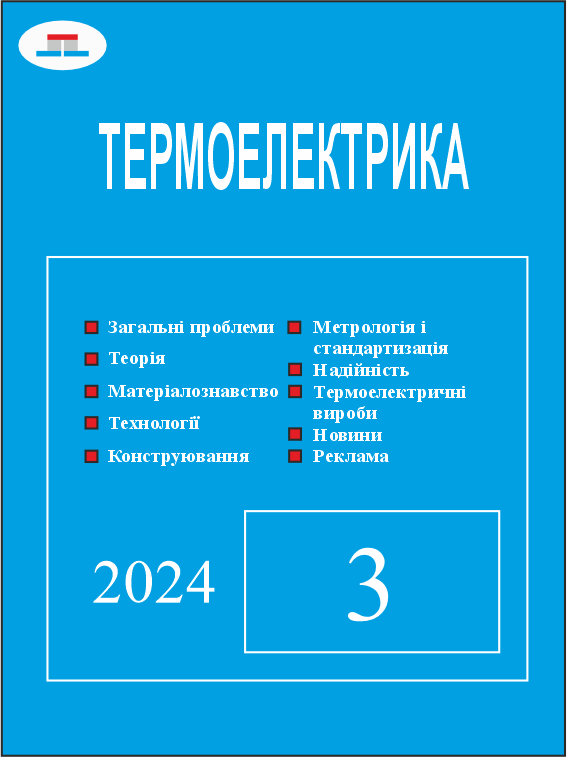Розробка високоефективних термоелектричних модулів з підкладками, виготовленими за технологією випарної камери
DOI:
https://doi.org/10.63527/1607-8829-2024-3-64-73Ключові слова:
термоелектричні модулі, теплопровідність, термоелектричні системи охолодженняАнотація
Термоелектричні системи широко використовуються в різних галузях промисловості. Основним фактором, що обмежує розширення діапазону застосування, є відносно низький холодильний коефіцієнт (СОР). Покращення продуктивності термоелектричних модулів (ТЕМ) є метою багатьох дослідницьких проектів протягом кількох десятиліть. Основні зусилля спрямовані на розробку нових ефективних матеріалів, але значного прогресу в характеристиках матеріалів, придатних для промислового використання, ще не досягнуто. Іншим способом підвищення продуктивності є оптимізація елементів структури модулів, зокрема підкладок. Відомо, що характеристики ТЕМ покращуються зі збільшенням теплопровідності підкладок. Найкращим кандидатом на високопровідні підкладки є випарна камера з ефективною теплопровідністю понад 5000 Вт/м/К, що приблизно в 30 разів вище, ніж у найкращих керамічних підкладок, виготовлених з ALN. Було розроблено, виготовлено та випробувано оптимізовані випарні камери, включаючи мідну оболонку з спеченим ґнотом і алюмінієву з рифленим ґнотом. Для підкладок гарячої та холодної мідної випарної камери використовувалися дві різні робочі рідини: вода та метанол. Ефективна теплопровідність мідних підкладок випарної камери становила близько 2500 Вт/м/К. Комп’ютерне моделювання показало, що ТЕМ з підкладками за технологією випарної камери (TEМВК) забезпечують більш рівномірний розподіл температури по поверхні тепловідводу та знижують температуру гарячих точок на кожній гілці. Як наслідок, ефективний термічний опір тепловідводу для ТЕМВК нижчий, ніж для звичайного TEM при тому ж розмірі модуля, структурі, розсіюваній потужності та параметрах тепловідводу. Для досліджуваного прикладу термоелектрична система, що включає ТЕМВК у зборі з тепловідводами, забезпечує підвищення COP відносно до звичайного ТЕМ приблизно на 40% за тих же умов. При використанні в якості генератора електроенергії ТЕМВК підвищує ККД більш ніж на 18%. Виготовлено та випробувано дослідні зразки ТЕМВК. Доведено хорошу кореляцію між теоретичними та тестовими даними.
Thermoelectric systems are widely used in different industrial applications. The main factor limiting rise of application range is relatively low Coefficient of Performance. Improvement performance of Thermoelectric modules (TEM) is a goal of multiple research projects during few decades. Main efforts are applied to development of new efficient materials but significant progress in performance of materials suitable for industrial use has not reached yet. Another way of performance improvement is optimization of modules structure elements, particularly substrates. It is known that performances of TEM are improved with increase of substrates thermal conductivity. The best candidate for highly conductive substrates is Vapor Chamber having effective thermal conductivity of more than 5.000 W/m/K which is about 30 times higher than the best ceramic substrates made from ALN. Optimized Vapor Chambers including copper envelope with sintered wick and aluminum with grooved wick were developed, manufactured and tested. Two different working fluids were used for the hot and cold copper Vapor Chamber substrates: water and methanol. Effective thermal conductivity of copper Vapor Chamber substrates was about 2.500 W/m/K. Computer simulations showed that Thermoelectric Modules with Vapor Chamber Substrates (TEVC) provides more even temperature distribution over the heat sink surface and reduces hot spot temperature on each leg. As a result, effective thermal resistance of heat sink for TEVC is lower than for regular TEM at the same module size, structure, power dissipation and heat sink parameters. For the studied example, thermoelectric system including TEVC assembled with heat sinks provides rise of COP relatively to regular TEM on about 40% at the same conditions. When used as power generator TEVC improves efficiency on more than 18%. Experimental samples of TEVC were manufactured and tested. Good correlation between theoretical and test data was proved. Bibl. 9, Fig. 12.
Посилання
1. Riffat, S. B., & Xiaoli, M. (2003). Thermoelectric: a review of present and potential applications. Applied Thermal Engineering, 23, 913-935.
2. d'Angelo, M., Galassi, C., & Lecis, N. (2023). Thermoelectric materials and applications: A review. Energy, 16, 6409.
3. Huang, L., Zheng, Y., Xing, L., & Hou, B. (2023). Recent progress of thermoelectric applications for cooling/heating, power generation, heat flux sensor and potential prospect of their integrated applications. Thermal Science and Engineering Progress, 45, 102064.
4. Sauciuc, I., Erturk, H., Chrysler, G., Bala, V., & Mahajan, R. (2005). Thermal devices integrated with thermoelectric modules with applications to CPU cooling. Proceedings of IPACK2005.
5. Gurevich, A., Steiner, I., & Huang, E. (2017). Design of thermal systems based on combination of thermoelectric and vapor chamber technologies. Proceedings of 33rd Thermal Measurement, Modeling & Management Symposium.
6. Lv, Y., Han, X., Chen, X., & Yao, Y. (2023). Maximizing energy output of a vapor chamber based high concentrated PV-thermoelectric generator hybrid system. Energy, 282, 128882.
7. Sarris, A., Bhatti, B., & Ciampra, F. (2022). Thermoelectric energy harvesting using vapor chamber coolers for aerospace applications. Journal of Intelligent Material Systems and Structures, 33, 1602.
8. Luo, D., Wu, H., Cao, J., Yan, Y., Yang, X., & Cao, B. (2024). Numerical investigation of a battery thermal management system integrated with vapor chamber and thermoelectric refrigeration. Journal of Cleaner Production, 434, 140089.
9. Maksymuk, M., Zazakowny, K., Lis, A., Kosonowski, A., Parashchuk, T., & Wojciechowski, K. T. (2022). Development of the anodized aluminium substrates for thermoelectric energy converters. Ceramics International.




